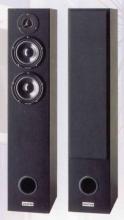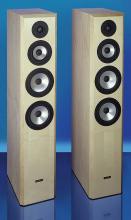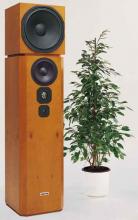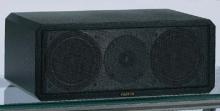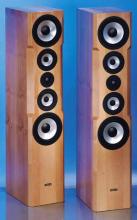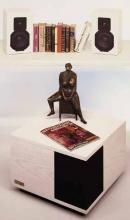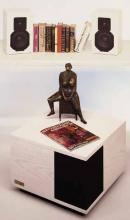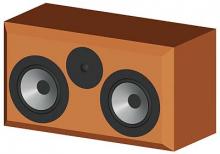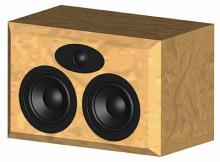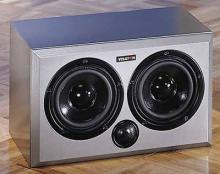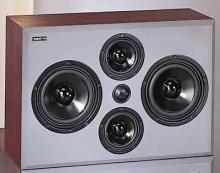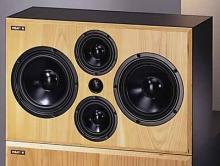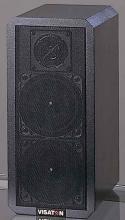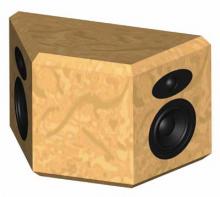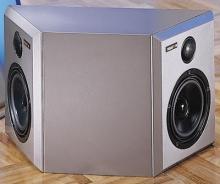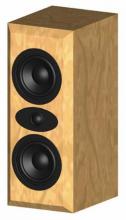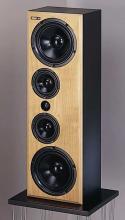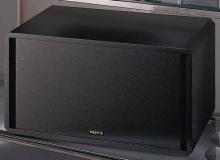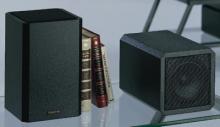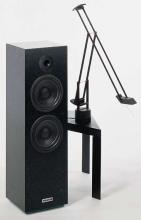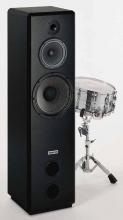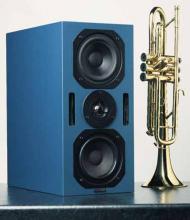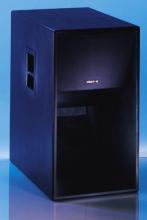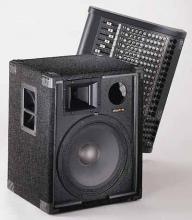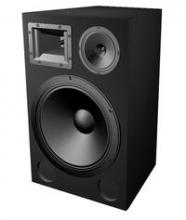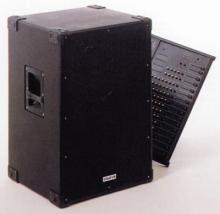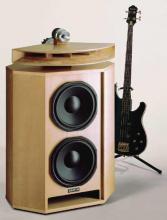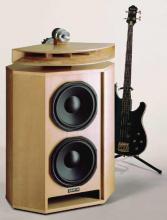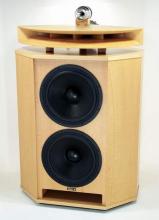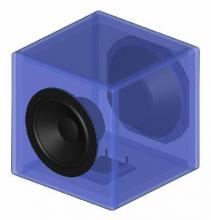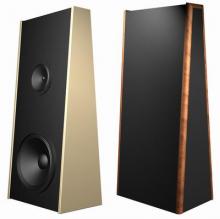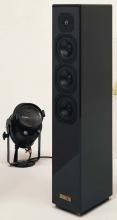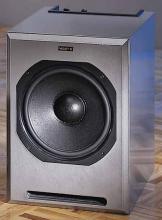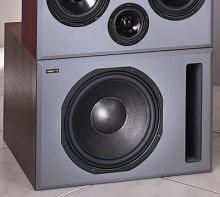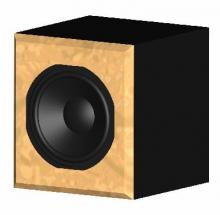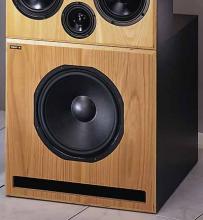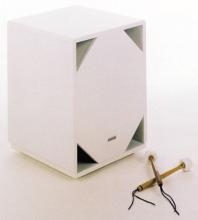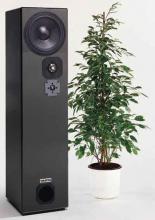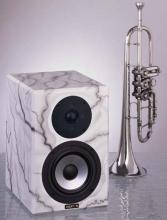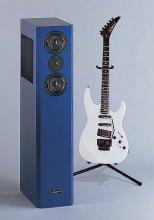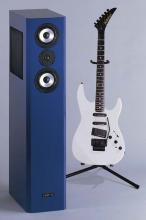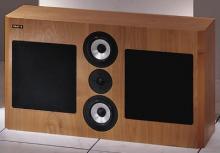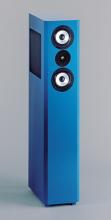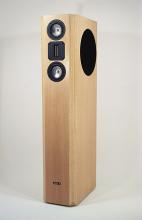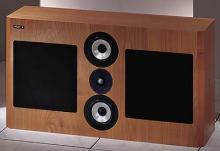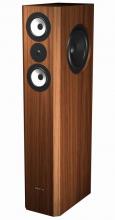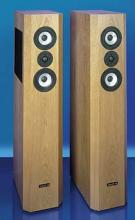Archive
ALTO LINE
Characteristics and sound properties
The ALTO LINE is a slim, 2-band column speaker with two 13 cm mid-bass units and one dome tweeter.
Due to its slim design and the correspondingly small footprint, this model is ideal as a free-standing speaker in smaller rooms.
The spatial separation is well handled by the speakers and can, as a result, produce clear sound characteristics even in "normal" living rooms.
The unusually broad range bass spectrum for a speaker of this size, that remains crisp even at higher output levels, is a point worthy of note.
As a result of its balanced, crisp sound characteristics, and the finely detailed, exuberant high-frequency output, the ALTO LINE can be considered a fully-fledged member of the ALTO speaker family.
- no longer available -ATLANTIS
The ATLANTIS has been consistently designed for optimum sound-pressure rating while retaining a moderately sized cabinet and an elegant appearance. In the bass range, two AL 170 8 OHM are mounted in parallel but in separate housings, where each has about 25 l of air space to itself. These speakers have a lower limiting frequency of 28 Hz meaning that they generate good, solid deep bass. Where you position the speakers is more or less a matter of choice, but they should not be right against the wall (a minimum of 10 cm is needed) as otherwise the effect of the bass reflex tubes will suffer.
Compared with the 'normal' AL 130 8 OHM, the AL 130 M 8 OHM is equipped with a shorter voice coil. This improves efficiency and makes it the ideal choice in this combination.
Used as a tweeter, the KE 25 SC 8 Ohm is activated from 2500 Hz. The distortion factor of this ceramic dome driver is really low at these frequencies, so that even high volume levels come across completely free of distortion.
- no longer available -
ATLAS COMPACT MK III
Characteristics and sound properties
For those who feel that the ATLAS DSM MK III is just too high and too wide, the ATLAS COMPACT MK III could be just the thing. The aim here was to slim down the size of the cabinets without compromising the excellent sound characteristics of the ATLAS DSM MK III. If you want to cut down the volume of a speaker cabinet without losing too much of the lower bass range, you have to use a bass driver with a smaller diaphragm area. As far as the lower frequency extremes are concerned, the ratio of diaphragm surface area to cabinet volume is of the utmost importance. In this context, the TIW 360 8 Ohm is the ideal bass speaker and the AL 170 8 Ohm optimal as a low- to midrange unit. Of course, a 40 cm subwoofer will generate more bass power than a 30 cm driver simply because it has a larger diaphragm surface area. But the tremendous power generated by the TIW 360 8 Ohm with optimal bass reflex tuning, should easily provide sufficient bass volume for most applications. The use of the same medium and high-range cones as in the ATLAS DSM MK III ensures a close relationship in terms of sound quality with the larger model.
ATLAS COMPACT MK IV
This, the fourth version of the ATLAS COMPACT, now boasts the latest driver highlights that the VISATON range has to offer. Apart from the TIW 360 8 OHM and AL 170 8 OHM used in the MK III version, the latest version makes use of the TI 100 8 OHM as the mid-range loudspeaker and KE 25 SC 8 OHM as the tweeter. The crossover unit has been completely redesigned and adapted to match the new drivers.
The baffle has also been changed. The wide bevels make the cabinetlook that much slimmer and prevent edge-reflexions in the more susceptible mid- and high-ranges. The bass reflex tube has also been modified. By using a larger tube, flow noise and losses have been reduced.
The ATLAS COMPACT MK IV is a very dynamic speaker with powerful deep-black bass reproduction but without getting woolly in the bass department. Additional features are absolutely neutral voice reproduction and crystal-clear high-frequency sounds without sharp edges.
ATLAS DSM MK III
The ATLAS DSM MK III is a superlative column speaker - not only because of its impressive height of 1.70 m, but above all because of its acoustic qualities.
The 5-way combination employs the TIW 400 8 Ohm high-tech speakers as long-stroke woofers, TIW 250 8 Ohm 's as internal drivers, GF 200 2 x 4 Ohm 's as fibre-glass mid-bass units and the tried-and-tested DSM 50 FFL 8 Ohm and DSM 25 FFL 8 Ohm titanium cones as mid- to high-range unit.
After considerably improving the bass range in the MK II version compared with its predecessor by using the TIW 250 8 Ohm as the inner driver, the current model has been further refined as the ATLAS DSM MK III - by including the GF 200 2 x 4 Ohm as the mid-bass unit. The result is far improved pulse dynamics, leading to even more pleasurable listening especially at peak levels.
Let it be said to all owners of the ATLAS DSM MK II, that conversion to the MK III version is remarkable easy. The crossover unit of the MK II has been retained with no change. The GF 200 2 x 4 Ohm can be fitted straight into the cut-out in the baffle of the WS 21 BF and its rim will neatly cover up the existing screw holes.
CENTER 130
For Dolby(r)surround and multimedia systems, where larger speakers are a requirement, the ideal choice is the CENTER 130 model. At the higher end of the range, the new magnetically screened 25 mm SC 10 N 8 Ohmtextile dome units are used. At the higher end of the range, the new magnetically screened 25 mm SC 10 N 8 Ohm textile dome units are used. The SC 13 8 Ohm 's are arranged symmetrically around the tweeter and are separated using two low-pass filters with differing characteristics in order to avoid wave cancellation affects around the tweeter. In this way, the sound source is always positioned around the centre and will match the on-screen visual action.
Thanks to the excellent power handling capabilities and the linear frequency response of the CENTER 130, home video presentations become a cinematic event. In multimedia applications, two CENTER 130's are used to reproduce the computer sounds, which really bring out the best in your soundcard.
CONCORDE MK II
The CONCORDE MK II 3-way system may not be able to fly, but in terms of sound, it really soars. The mere shape and the drivers used give an idea of its qualities. The tailored baffle in the medium to high-frequency range produces optimised omnidirectional sound distribution one of the reasons why the sound distribution throughout the room is so smooth. Arranging all the drivers according to the d Appolito principle, reduces interference from floor and ceiling reflection. Two AL 200 8 Ohmaluminium bass drivers join forces to produce profound and yet precise bass reproduction thanks to the extra-large, flow-optimised bass reflextube. The two AL 130 8 Ohm mid-range speakers guarantee crisp mid-range sounds as a result of their stiff cones, long stroke and impedancecontrol ring.
At the top end of the frequency range we have used the innovative KE 25 SC 8 Ohm ceramic tweeter, which has been incorporated using a sophisticated crossaver arrangement to optimise timing. This sophisticated design of tweeter can be wired up to blend in from a very low level and, as with all the other drivers, produces extremely distortion-free sound even at high volume settings. Any defects in the source signal are laid wide open. Even at louder settings, listening to music remains a real pleasure. This is always a good sign that the baffle is working correctly and that nothing is being smuggled in that should not be there.
In the MK II version, a slight adjustment in the mid-range section of the crossover has enhanced the crossover range between the mid-range and tweeter.
The completely neutral tonality and the remarkable dynamic characteristics of this stand-up CONCORDE MK II cabinet make it an all-round talent for discerning listeners of all types of music.
Warning: This loudspeaker is as honest as they come and conceals nothing!
CONVENTION MK IV SAT
Subwoofer satellite arrangements are becoming ever more popular amongst those who simply do not have room to place large-scale speakers or who are unwilling to have large items of furniture around, but who do not wish to go without the enjoyment of powerful, low-range bass. Since low-frequency sounds below 100-150 Hz cannot be located by the human ear, only one subwoofer cabinet is required. The difficulty here is the combination of left- and right-channel low-range frequencies into a single loudspeaker. An uncompromising solution to this is an active crossover unit, which has a corresponding effect on costs. Special loudspeakers with completely separate voice coils make a simple construction of the subwoofer crossover unit possible. If you are intending to use normal bass speakers, a smart trick will solve this problem and kill two birds with one stone: the compound principle. With this arrangement, two bass speakers are screwed together in such a way that they are acoustically coupled via a small air volume. This produces a loudspeaker with two separate voice coils. Despite the relatively small volume in the chamber, very low frequency extremes are achieved. When connecting up the woofers, remember to transpose the polarity on one of them as otherwise the two speakers will be working against each other. In order to ensure the satellite speakers are perfectly matched to the subwoofers, they are vented, too. This enables the volume to be raised at lower frequency ranges. At around 3,000 Hz the ferrofluid-filled textile DTW 95 NG 8 Ohm takes over. A characteristic of this dome tweeter is the "smooth" high-range treatment. If more brilliant high-range frequency output is required, the DSM 25 FFL 8 Ohm with its metal cone can be substituted without altering the crossover unit.
CONVENTION MK IV SUB
Subwoofer satellite arrangements are becoming ever more popular amongst those who simply do not have room to place large-scale speakers or who are unwilling to have large items of furniture around, but who do not wish to go without the enjoyment of powerful, low-range bass. Since low-frequency sounds below 100-150 Hz cannot be located by the human ear, only one subwoofer cabinet is required. The difficulty here is the combination of left- and right-channel low-range frequencies into a single loudspeaker. An uncompromising solution to this is an active crossover unit, which has a corresponding effect on costs. Special loudspeakers with completely separate voice coils make a simple construction of the subwoofer crossover unit possible. If you are intending to use normal bass speakers, a smart trick will solve this problem and kill two birds with one stone: the compound principle. With this arrangement, two bass speakers are screwed together in such a way that they are acoustically coupled via a small air volume. This produces a loudspeaker with two separate voice coils. Despite the relatively small volume in the chamber, very low frequency extremes are achieved. When connecting up the woofers, remember to transpose the polarity on one of them as otherwise the two speakers will be working against each other. In order to ensure the satellite speakers are perfectly matched to the subwoofers, they are vented, too. This enables the volume to be raised at lower frequency ranges. At around 3,000 Hz the ferrofluid-filled textile DTW 95 NG 8 Ohm takes over. A characteristic of this dome tweeter is the "smooth" high-range treatment. If more brilliant high-range frequencyoutput is required, the DSM 25 FFL 8 Ohm with its metal cone can be substituted without altering the crossover unit.
Not available as a complete kit.
COUPLET CENTER
This version of the COUPLET has been specifically designed for use as a centre speaker in multichannel systems. The drivers and crossover fitted are the same as in the original COUPLET. However, instead of the bass reflex arrangement, a smaller, enclosed housing has been selected. This saves space. The loss of deep-bass that this involves is of no consequence if the centre channel is run in small mode, since this means the bass below 80 or 100 Hz is transferred to the main speakers or subwoofer.
Normally, there is not enough space to stand the cabinet up in a bookshelf, or above or below the TV set. If it is laid on its side, the radiation pattern will suffer as a result of the horizontal sound focussing effect. This will be noticed if the listener is seated to one side of the optimum seating position. As a result, this sample arrangement places the tweeter outside the main axis while the woofers are moved closer together.
Use of these speakers in the vicinity of a TV set requires the drivers to be magnetically shielded. Otherwise, there will be distortions and incorrect colouration on the screen . The G 20 SC - 8 Ohm tweeter used here is already magnetically shielded. The AL 130 - 8 Ohm mid-bass units can easily be shielded using the KM 80 compensating magnet which is simply glued to the rear of the magnet system. One KM 80 per driver will lead to a reduction in the scatter field and, in many cases, a second KM 80 will lead to even greater improvement. This will depend on the sensitivity of the TV set and the exact position of the speakers.
CT CENTER 100
This compact centre speaker will find a suitable space in the shelving just above or below the TV set. It is fitted with two W 100 SC 4 Ohm 's connected in series, which produces a total impedance of 8 ohms. As a result, the CT CENTER 100 can be used in conjunction with receivers that have problem communicating with low-impedance speakers. Up in the high-frequency range, the G 25 ND 8 Ohm, a 25 mm textile dome unit with a Neodym magnet, performs well. The tweeter is arranged asymmetrically between the woofers in order to achieve an enhanced horizontal radiation pattern. All the drivers are, of course, magnetically shielded to prevent annoying interference effects on TV screens.
Apart from the CineTOP 100 combination consisting of 2x CT MAIN 100, 1x CT CENTER 100, 2x CT DIPOL 100 and the active subwoofer, it is also possible to combine the Centre and Dipole speakers with small or medium-sized upright speakers such as the ALTO II, ALTO III C or ALTO LINE. As subwoofer, the SUB W-20.39 would be a suitable choice.
CT CENTER 130
The CT CENTER 130 has been specially developed with a particular driver arrangement in mind to provide perfect omnidirectional sounddispersion and to ensure the sound source is close to the image. Spoken dialogues can thus be directly located and correctly positioned even 30° from the centre line without distortion. The W 130 SC 4 Ohm loudspeaker model and the 25 mm SC 4 ND 4 Ohm titanium tweeter with its neodym magnet are magnetically shielded. The sealed 2-way speaker, with only 8 litres net cabinet volume, has a Q-rating of 0.7 and a linear frequency response of 100 Hz to 20,000 Hz. If used, as recommended, at 100 Hz at above, it can easily manage maximum levels of 105 dB. During the development of the system, care was taken to ensure that the high rated impedance allows its use with virtually any amplifier. If the speaker is not supplied with an amplifier signal which is trimmed under 100 Hz, it is advisable to add the recommended passive high-pass filter, in order to prevent overloading at higher output levels in the lower bass frequencyranges. As an option, it is possible to combine the CT CENTER 130 with an additional SUB T-25 active subwoofer with a cut-off frequency of 100 Hz which produces a high-grade centre system, which covers the entire frequency range, has excellent power handling capabilities and still remains very compact, enabling it to be easily positioned. The CT CENTER 130 can be used in all CineTOP systems, such as the CineTOP 170 or 200 for normal sitting-room use. If placed upright, the CT CENTER 130 can also be used as a main loudspeaker for compact home video applications, where it would require the support of a subwoofer, e.g. SUB-T 25. The CT CENTER 130 is characterised by its excellent omnidirectional sound distribution and balanced sound qualities, that reproduce film soundtracks in all their colour and depth.
CT CENTER 170
CT CENTER 170 is based on the CT MAIN 170 main loudspeakers and acts as a Centre Speaker, where the only difference is that it is designed to lie on its side. Since the speaker arrangement and crossover unit are identical in every respect, this centre system is ideal for use with THX® systems. With its linear frequency response of 80 Hz 20,000 Hz in an enclosed cabinet with a total Q-rating of 0.7, the required vertical beaming and a maximum sound pressure of 108 dB, this system leaves nothing to be desired. The loudspeakers used, W 100 SC 4 Ohm and W 170 SC 4 Ohm, are magnetically shielded and the shielding of the complete speaker unit corresponds to THX® regulations (3-Gaussian curve). This means that the entire speaker can also serve as a stand for a TV set. The speaker is a titanium dome tweeter with a neodym magnet. The CT CENTER 170 can also be used as a main loudspeaker and, because of its overall dimensions, can be placed on top of a SUB T-36 subwooferwhich is lying on its side.This speaker has extremely clear bass reproduction with a well-balanced overall sound quality, providing a realistic impression of live sound. Even high volume settings come across naturally and undistorted. The designers placed emphasis on hig impedance, so that the speakers can be connected up to virtually any amplifier with no problems. We recommend using this system in conjunction with CT MAIN 170 main loudspeakers, the CT DIPOL 130effect speaker and the SUB T-36 subwoofer. The realistic soundreproduction especially for films is so close to the original that the listener feels as if they are right in the thick of it. This system is a joy to listen to.
CT CENTER 200
CT CENTER 200 is based on the CT MAIN 200 main loudspeakers and acts as a Centre Speaker, where the only difference is that it is designed to lie on its side. Since the speaker arrangement and crossover unit are identical in every respect, this centre system is ideal for use with THX® systems. With its linear frequency response of 80 Hz 20,000 Hz in an enclosed cabinet with a total Q-rating of 0.7, the required vertical beaming and a maximum sound pressure of 108 dB, this system leaves nothing to be desired. The loudspeakers used, W 130 SC 4 Ohm and W 200 SC 4 Ohm, are magnetically shielded and the shielding of the complete speaker unit corresponds to THX® regulations (3-Gaussian curve). This means that the entire speaker can also serve as a stand for a TV set. The speaker is a titanium dome tweeter with a neodym magnet. The CT CENTER 200 can also be used as a main loudspeaker and, because of its overall dimensions, can be placed on top of a SUB T-40 subwoofer. This speaker has extremely clear bass reproduction with a well-balanced overall sound quality, and impressive spatial separation. High volume settings, particularly important to reproduce live sound, come across powerfully, naturally and undistorted involving the listener directly in the action. The designers placed emphasis on high impedance, so that the speakers can be connected up to virtually any amplifier with no problems. We recommend using this system in conjunction with CT MAIN 200 main loudspeakers, the CT DIPOL 130 effect speaker and the SUB T-40subwoofer. The virtually perfect reproduction of the sound channels is so close to the original that the listener feels as if they are personally involved in the action. Makes films into an experience.
CT CENTER 80
The CT CENTER 80 is a compact, enclosed 2-way system with well-balanced sound quality and complete magnetic shielding, as required for example if positioned close to a TV or PC. Inside the cabinet, we use magnetically shielded speakers, types SC 8 8 Ohm (8 cm full-range) and SC 5 8 Ohm (10 mm tweeter) and the complete speaker then meets the shielding requirements of the THX® regulations (3-Gaussian curve). The asymmetric design of the front baffle and of the crossover unit provide good omnidirectional sound distribution both vertically and horizontally. It is possible to install the speakers in the upright position, as is usual for multimedia systems, or lying down on top of a TV, as is usual with surround systems. This also provides for application in a subwoofersatellite system with the CT SUB 80. In terms of sound quality, the CT CENTER 80 produces clear-cut sound, well removed from the speakers, but with remarkably well-formed bass reproduction for a system of this size. In conjunction with the CT SUB 80 system and two CT EFFECT 80's, the CT CENTER 80 provides an excellent surround sound "starter" system, that will transport viewers right into the centre of the action with centrally located dialogues, background noises and dramatic soundeffects.
CT DIPOL 100
This dipole speaker makes use of two W 100 S 4 Ohm and two G 25 ND 8 Ohm textile dome units. The idea of dipoles is to create a diffused sound field from the effect channels. For this reason the tweeters at the front and rear are cross-connected. The all-pass circuitry in the deep-bass department ensures that, at frequencies above 200 Hz, the woofers are also cross-connected, and below that level they work in synch. This prevents the bass completely cancelling itself out. The two dipoles should be positioned at both sides of the listening position and just above ear-height or mounted on the wall at that height.
Apart from the CineTOP 100 combination consisting of 2x CT MAIN 100, 1x CT CENTER 100, 2x CT DIPOL 100 and the active subwoofer, it is also possible to combine the Centre and Dipole speakers with small or medium-sized upright speakers such as the ALTO II, ALTO III C or ALTO LINE. As subwoofer, the SUB W-20.39 would be a suitable choice.
CT DIPOL 130
Characteristics and sound properties
Our CT DIPOL 130 is a dipole loudspeaker conforming to the THX® regulations for positioning close to walls. As a result of the special characteristics of this dipole, a completely free-standing diffuse sound field is generated. The system uses two mid-bass W 130 S 4 Ohm and two 25 mm titanium SC 4 ND 4 Ohm dome tweeters with neodym magnets. In the medium and high-range, the opposing loudspeakers operate from separate enclosed chambers that are phase shifted by 180°. Up to a frequency of 200 Hz, the mid-bass drivers work in sync. This is possible because of the special crossover circuitry, to ensure that, in the bass range, and despite the dipole principle, sufficient sound is produced. According to the THX® regulations, such a dipole system must cover a frequency range of 125 Hz - 10,000 Hz. The CT DIPOL 130 achieves this with no effort, as it does the maximum sound pressure requirements of 102 dB. The designers placed emphasis on high impedance, so that the speakers can be connected up to virtually any amplifier with no problems. The CT DIPOL 130 can, however, easily be integrated into normal Dolby®-Surround systems. If the speaker is not supplied with an amplifier signal which is trimmed under 100 Hz, it is advisable to add the recommended passive high-pass filter, in order to prevent overloading at higher output levels in the lower bass frequency ranges. As an option, two dipoles (left and right) can be combined with an active subwoofer SUB T-25 with a cut-off frequency of 100 Hz to produce the ideal surround channel system, which will cover the entire frequency range. The system experiences no trouble in achieving the high power-handling capabilities for fullrange use. The ideal position for the CT DIPOL 130 to provide ideal listening pleasure is to the side of the sitting position, either hanging on the wall about 1 m -1.5 m off the floor or on corresponding stands. The speakers can be used in all CineTOP systems, such as CineTOP 130, CineTOP 170 and CineTOP 200 for smaller and large rooms. The CT DIPOL 130 system is also an optimum choice for improving an existing home video system. This Dipole is characterised by its excellent diffuse sound field that will surround the listener with a carpet of sound. The tangible yet not locatable spatial effects will turn your sitting room into a cinematic experience.
CT MAIN 100
For use as a small satellite, the CT MAIN 100 is equipped with a pair of W 100 S 4 Ohm and the G 25 ND 8 Ohm textile dome unit. The two woofers are connected in series, which produces a total impedance of 8 ohms. As a result, the CT MAIN 100 can be used in conjunction with receivers that have problem communicating with low-impedance speakers. The drivers are arranged symmetrically on the baffle based on the D'Appolito principle, where the oval front panel of the tweeter leaves only very little space between the woofers.
The CT MAIN 100 can be used as the main speaker in a multichannel system (e.g. CineTOP 100 combination using 2x CT MAIN 100, 1x CT CENTER 100 and 2x CT DIPOL 100, boosted with an active subwoofer), or as the satellite in a stereo system. As subwoofer, the SUB W-20.39would be a suitable choice.
CT MAIN 170
The CT MAIN 170 speaker was originally developed as a main loudspeaker for home video applications but is equally well suited to listening to hi-fi music. This enclosed 3-way cabinet features a front bafflearrangement based on the D Appolito principle arranged symmetrically around the 25 mm titanium SC 4 ND 4 Ohm tweeter with neodym magnets. The loudspeakers used, W 100 SC 4 Ohm and W 170 SC 4 Ohm, are magnetically shielded. In order to suppress any unwanted interference by the baffle on the radiation pattern, the entire mid- to high-range unit is not positioned in the middle of the cabinet, but towards the inner side. The linear frequency response of the speaker is 80 Hz 20,000 Hz, which produces a total Q-rating of 0.7 in combination with the vertical beaming effect, and a total SPL of over 108 dB, corresponding to the THX® requirements. The CT MAIN 170 can equally well be used in small or large rooms. Mounted on a stand, the cabinet becomes an column speaker. The CT MAIN 170 produces precise bass reproduction and an exceptionally well balanced sound experience that is able to compete with live music. Even high volume settings will come over naturally and will not lead to distortion. The designers placed emphasis on high impedance, so that the speakers can be connected up to virtually any amplifier with no problems. We recommend using this system in conjunction with CT CENTER 130 or CT CENTER 170 centre speakers, the CT DIPOL 130effect speaker and the SUB T-36 subwoofer. The virtually perfect reproduction of the sound channels is so close to the original that the listener feels as if they are personally involved in the action. Makes films into an experience.
CT MAIN 200
The CT MAIN 200 speaker was originally developed as a main loudspeaker for home video applications but is equally well suited to listening to hi-fi music. This enclosed 3-way cabinet features a front bafflearrangement based on the D'Appolito principle arranged symmetrically around the 25 mm titanium SC 4 ND 4 Ohm tweeter with neodym magnets. The loudspeakers used, W 130 SC 4 Ohm and W 200 SC 4 Ohm, are magnetically shielded. In order to suppress any unwanted interference by the baffle on the radiation pattern, the entire mid- to high-range unit is not positioned in the middle of the cabinet, but towards the inner side. The linear frequency response of the speaker is 80 Hz -20,000 Hz, which produces a total Q-rating of 0.7 in combination with the vertical beaming effect, and a total SPL of over 110 dB, corresponding to the THX® requirements. The CT MAIN 200 can equally well be used in small or large function rooms. Mounted on a stand, the cabinet becomes an column speaker. The CT MAIN 200 provides precise bass reproduction and exceptionally good sound quality and spatial separation. Peak volume levels, so important for a realistic live sound experience, come over naturally and without the slightest distortion. The designers placed emphasis on high impedance, so that the speakers can be connected up to virtually any amplifier with no problems. We recommend using this system in conjunction with CT CENTER 130 or CT CENTER 200 centre speakers, the CT DIPOL 130 effect speaker and the SUB T-40subwoofer. The virtually perfect reproduction of the sound channels is so close to the original that the listener feels as if they are personally involved in the action. Makes films into an experience.
CT SUB 80
We are proud to present the CT CENTER 80, specially designed for Dolby®-Surround applications. This is a highly compact system for the home video centre channel (240 x 105 x 200 mm; fitted with 2 x SC 8 8 Ohm, 1 x SC 5 8 Ohm ). This loudspeaker has well-balanced soundqualities. For this reason, we recommend using two CT CENTER 80 's as satellite speakers in conjunction with a specially designed subwoofer as main loudspeakers. The CT CENTER 80 speaker is then used three times: as the centre speaker and as a main loudspeaker with a subwooferbooster. This sub/sat system is also well suited to compact hi-fi stereo systems. For the subwoofer, the bandpass principle has been chosen, since it is only this arrangement with a passive crossover unit that the low cut-off frequency of 125 Hz can be achieved at the same time as a high slope rate. The system uses two magnetically shielded W 130 SC 4 Ohmloudspeakers, each supplied by one channel (R+L). The high pass for hooking up the satellite speakers is also integrated in the crossover unit. The frequency curve shows that we have managed to raise the slope rateto such a level that the subwoofer cannot be located. Furthermore, the satellite speakers are freed of their subwoofer content, which means they come across extremely clearly even at high output levels. Thanks to its compact dimensions, the CT SUB 80 system can be placed discretely anywhere in the room and the magnetically shielded subwoofer can even be used as a base for a TV set. The frequency curve also shows that the system has remarkably good efficiency for its size - and retains a voluminous, even warm sound character. The spatial reproduction is extremely good - a characteristic of smaller satellite speakers. The CT SUB 80 system when combined with the CT CENTER 80 and two CT EFFECT 80 's will provide an excellent surround starter set, that will present the listener with centrally placed dialogues, background noises and dramatic sound effects that all in all will put you right at the heart of the action.
EFFECT 130
The EFFECT 130 is a Dolby® Surround effect speaker and can easily be used in conjunction with a CENTER 130 system. Thanks to the magnetically shielded SC 13 8 ohm driver, the system will be able to achieve the sound volumes required for clear reproduction of Dolby® Surround effects even in larger rooms. When Dolby® Surround signals are encoded, the upper frequency range is topped off at 7000 Hz, which is why the SC 13 8 ohm speaker, which remains linear up to around 10 kHz, is ideally suited to this application. In order to achieve spatial surround effects irrespective of the seating position, the SC 13 8 ohm has been designed to radiate the sound upwards.
The EFFECT 130 speakers can be located either freely around the room or mounted on the wall, where this should be behind or to the side of the seating position.
FIESTA 20
Connoisseurs of crisp, powerful bass and clear higher range frequencies, coupled with excellent power-handling capabilities, will welcome the 65-litre FIESTA 20 speaker, because it was designed specifically for them.
A special crossover circuit enables the two W 200 NG 8 Ohm to work in the bass range in tandem up to around 120 Hz. After that, the output level of the lower speaker is lowered and the upper W 200 NG 8 Ohm takes over the mid-range. The pressure chamber system of the DHT 9 8 Ohmproduces high-range dynamics with amazing signal fidelity and is effectively protected against overloading by the voltage attenuator connected in series.
The special sound characteristics of this system will appeal mainly to rock music fans. This musical genre often requires high output levels and needs the right punch in the bass range. It is precisely these features, good power handling capabilities and authentic bass reproduction coupled with a moderate price that make the VISATON FIESTA 20 what it is.
FIESTA 30
A loudspeaker that produces similar sound characteristics in the hi-fi field as the FIESTA 20, but, due to its higher efficiency rating, can also double up as a speaker for the electronic organ at home and be used in the party room; that is the FIESTA 30.
At the lower end of the frequency scales in this all-round system, we find the tough 12" BG 30 NG 8 Ohm in a generously sized 130-litre vented cabinet. The mid- to high-range is covered by the new BG 20 8 Ohm and the DHT 9 8 Ohm tweeter horn.
The result is a high efficiency rating of 91 dB (1 W/1 m) at impedancelevels that are not amplifier-sensitive and a music load of no less than 250 W.
The robust reproduction quality required for party use or for a musician is complemented adequately by the smooth frequency response with the neutral hi-fi sound qualities required in a home listening environment.
FILOU
The FILOU is a D'Appolito configuration designed as a shelf-mounted speaker, but thanks to its excellent bass reproduction, can also be free-standing. It is based on the vented cabinet principle. The bass to mid-range is covered by two WS 13 BF 8 Ohm speakers. The extremely small moving mass coupled with the powerful driver and the rounded overall concept of this 13cm driver makes it possible to use it as a mid-range unit. At about 2,600 Hz, the two mid-bass units working in parallel are reduced and the DT 94 8 Ohm dome tweeter linked up. The FILOU is characterised mainly by its powerful and accurate bass reproduction and, due to the high efficiency level, lively, bubbly music reproduction. Its excellent sound distribution characteristics contribute to spatial clarity and good positioning with music. Thanks to the relatively high efficiency rating coupled with good power handling capabilities, louder volume levels can be easily achieved with no sound distortion. As long as the overall cabinetvolume is retained, the unit can be built slightly wider and shorter (e.g. width: 230 mm, depth: 300 mm).
MB 115/B
The MB 115/B building suggestion is a bass speaker for professional musicians. If fullrange musicians' speakers need boosting the bass department, you need bass speakers with a comparatively high level of efficiency. Bass reflex speakers have the advantage of a low limiting frequency, but this also means they need a large cone area with the large cabinet that this entails, in order to produce sufficient sound pressure. A completely uncompromising bass speaker should really be enormous. However, the MB 115/B makes use of a cleverly designed flare geometry, perfectly matched to the BGS 40 - 8 Ohm driver, to produce a relatively compact horn. A limiting frequency of 50 Hz is a perfectly respectable level for a musician coupled with an output level of 96 dB above 60 Hz under open-field conditions (no walls, no floor) at just 1 watt is an excellent starting point for extreme bass pressure. It must be taken into account that, positioned on the floor away from walls, this figure increases by 3 dB and near a corner by as much as 9 dB. We measured peak output levels of as much as 125 dB (above 60 Hz) under favourable conditions. And all that with the typical horn-like, bone-dry sound characteristics an experience for aficionados of solid-level, dynamic sound!
The horn sound develops in a vortex beginning in front of the diaphragm and moving outwards towards the opening. At the rear, the woofer acts on a small, enclosed compartment. This prevents the stroke in the low bass and subsonic ranges from becoming too extreme which prevents mechanical damage to the driver. The impedance curve retains a pleasingly high level throughout. This means that the booster is not overloaded and the voice coil does not overheat. Crucial points in the tough daily life of professional musicians.
Active separation is recommended. This allows the optimal position between separating frequency and slope rate to be found. As a cost-saving alternative, we have also developed a passive crossover. This system separates at 150 Hz and goes well with the top-of-the-range MB 208/H, if the recommended high-pass section is used ( refer to MB 208/H ).
MB 115/H
The MB 115/H professional musician's speaker is a compact, excellent value for money vented cabinet. It is equipped with the BGS 40 - 8 Ohm woofer and the HTH 8.7 - 8 Ohm mid- to high-range horn. A 2-way combination has the invaluable advantage of simplicity. However, combining a 15" woofer with a tweeter is not completely without its problems, since the cone of the woofer must also produce resonance-free and distortion-free sound in the mid-range. The tweeter, for its part, has to be distortion-free at relatively low frequencies and, at the same time, have good power handling capabilities. We decided on a cut-off frequency of 3000 Hz - a level both speaker drivers can cope with effortlessly.
The rated power output of the speaker is 200 watts. This rating is determined in accordance with the DIN standards using a permanent noise signal. This value is, however, far removed from practice, since music consists of many different impulses and surges. The effective value, that also tells us something about the heating-up of the voice coil, is much lower with music. We have successfully tested the MB 115/H with a professional-quality amplifier up to the clipping limit, so we are safe in saying it has a music rating of 500 watts. At this level, peak outputs of 120 dB are achieved at a distance of one metre.
MB 156/3
The MB 156/3 extends the range of musicians' speakers available from Visaton by adding one new 3-way combination. The bass department is controlled in this arrangement by the BGS 40 - 8 Ohm, which is a carry-over from the successful MB 115/H. The mid-range is provided by the BG 17 - 8 Ohm which, thanks to its high sensitivity level, has no problem at all matching the output level of the woofer. The combination is neatly rounded off at the top range of frequencies by the HTH 8.7 - 8 Ohm horn which has also already made a good impression in other speakers.
To ensure that the high sensitivity of the BGS 40 - 8 Ohm, which on average is 95 dB (1 W/1 m), is also achieved at the low frequency range, there are two bass reflex vents in the baffle. Having the tuning frequency set at a high 55 Hz means that the thickness of the material used for the front panel is sufficient as the length of the bass reflex tubes. No tunnels or tubes are required.
A well-tuned crossover ensures that each of the three drivers only deals with the range of frequencies for which it was originally designed. In the case of the MB 156/3, this arrangement results in a highly linear frequency response, even at high output levels, which is close to hi-fi needs.
MB 212/H
For sound reproduction in large halls or in the open, you need loudspeakers with a high efficiency rating. This means that the electrical input has to be converted to sound output with the minimum possible loss. Since the mid- and high-range sound is dampened more than the bass sound as the distance from the loudspeaker increases, the frequency response of a speaker designed for this application has to rise as you move up the frequency scale. Otherwise, the speaker will sound dull at a distance.
The MB 212/H musician's P.A. system has the required characteristics and is therefore well suited to use in discos, as an outside small-volume P.A., or as a vocals and instrument speaker. The two powerful 30-cm musician's subwoofers run parallel up to around 4,000 Hz, at which point the robust, but neutral-sounding HTH 8.7 8 Ohm high-range flare takes over.
The following calculation shows how important it is to have the right efficiency rating for professional P.A. speakers: the MB 212/H speaker generates a mean sound pressure of 98 dB at 1 watt and at 1 metre from the speaker. At the maximum permanent load of 300 W, the maximum achievable at 1 metre is 123 dB. In the open, measured at 60 metres from the speaker, the level is merely 87 dB.
Suppose we were to use a normal hi-fi speaker with a high efficiency rating of 90 dB/1 W/1 m, it would take 1,900 watts (!) to achieve 87 dB at a distance of 60 metres. As you can see, no normal hi-fi speaker is in a position to achieve anything like the required compression-free sound output.
MONITOR 890 MK II
It is well-known that there are two types of loudspeakers: hi-fi speakers that produce the most accurate, unaltered sound possible, and disco or musician's speakers, where the top volume level is of the utmost importance. These volume levels are normally only possible with horns but these often cause coloration of the sound. The MONITOR 890 MK IIwas designed specifically to combine the best of both worlds. In the mid-range, we use a driver & horn unit which is so dynamic and produces such undistorted music, that many a horn-disparager has had to admit that this is simply unbelievably "different". Two excellent quality woofers, TIW 360 8 Ohm, mounted in the 180 litre vented cabinet, generate a bass sound pressure that is physically tangible, as you have experienced with concert speakers. Combined with the first-rate TL 16 H 8 Ohm high-range horn, we have created a loudspeaker system that breaks down the previously unbridgeable barrier between the hi-fi and the professional speaker.
We recommend, initially at least, the following level settings: tweeter: -4 dB; mid-range: -4 dB
Thanks to the added impedance linearising unit in the crossover unit, the Monitor 890 MK II is now even better suited to use with critical amplifiers (e.g. tube amplifiers).
MONITOR 890 MK II / TL
It is well-known that there are two types of loudspeakers: hi-fi speakers that produce the most accurate, unaltered sound possible, and disco or musician's speakers, where the top volume level is of the utmost importance. These volume levels are normally only possible with horns but these often cause coloration of the sound. The MONITOR 890 MK II / TL was designed specifically to combine the best of both worlds. In the mid-range, we use a driver & horn unit which is so dynamic and produces such undistorted music, that many a horn-disparager has had to admit that this is simply unbelievably "different". Two excellent quality woofers, TIW 360 8 Ohm, mounted in the 180 litre vented cabinet, generate a bass sound pressure that is physically tangible, as you have experienced with concert speakers. Combined with the first-rate TL 16 H 8 Ohm high-range horn, we have created a loudspeaker system that breaks down the previously unbridgeable barrier between the hi-fi and the professional speaker.
We recommend, initially at least, the following level settings: tweeter: -4 dB; mid-range: -4 dB
Thanks to the added impedance linearising unit in the crossover unit, the Monitor 890 MK II / TL is now even better suited to use with critical amplifiers (e.g. tube amplifiers).
MONITOR 890 MK III-TL
It is well-known that there are two types of loudspeakers: hi-fi speakers that produce the most accurate, unaltered sound possible, and disco or musician's speakers, where the top volume level is of the utmost importance. These volume levels are normally only possible with horns but these often cause coloration of the sound. The MONITOR 890 MK IIIwas designed specifically to combine the best of both worlds. In the mid-range, we use a driver & horn unit which is so dynamic and produces such undistorted music, that many a horn-disparager has had to admit that this is simply unbelievably "different". Two excellent quality woofers, TIW 300 8 Ohm, mounted in the 180 litre vented cabinet, generate a bass sound pressure that is physically tangible, as you have experienced with concert speakers. Combined with the first-rate TL 16 H 8 Ohm high-range horn, we have created a loudspeaker system that breaks down the previously unbridgeable barrier between the hi-fi and the professional speaker.
The output levels of the mid-range driver and tweeter can be adjusted to the requirements of the locale using output controls. We recommend, initially at least, the following level settings: tweeter: -4 dB; mid-range: -4 dB. These can, of course, be adapted to suit the specific acoustics in the room and personal preferences.
Thanks to the added impedance linearising unit in the crossover unit, the Monitor 890 MK III is now even better suited to use with critical amplifiers (e.g. tube amplifiers).
NANO SUB PR
The NANO SUB PR is a smaller alternative to the original NANO SUB. The capacity of the cabinet has been reduced to 20 l. In order to achieve the required low tuning frequency with such a small cabinet, the bass reflex tube will either have to be extremely long or have a very small cross-section. Both will lead to considerable airflow losses. So instead of using a bass reflex tube, we use a PR 250 radiator. This enables us to design a far more compact subwoofer and, at the same time, compromise as little low-frequency bass as possible.
The tuning frequency can be adjusted on the PR 250 by means of the additional mass. Without the additional mass, 36 Hz is possible and with the enclosed nut and bolt, 30 Hz. Of course, since every room has its own acoustic properties, you should select the option that provides the best actual listening pleasure.
Apart from being used in the passive NANO SUB/SAT system, the NANO SUB PR can, of course, also be used in an active system, e.g. in conjunction with a Thommessen Proteus SW 0.8 amplifier. In this case, the GF 200 2 x 4 Ohm voice coils are connected in series while the passive crossover and terminal connections are no longer needed.
Not longer available.
NoBox BB
The NoBox BB unites a number of preferences in a single concept: it achieves the directness of a full-range loudspeaker, in particular in the voice range, and also manages to produce powerful, stable bass without having to fill the room with hardware.
The B 200 - 6 Ohm is used in the NoBox BB together with a 38 cm BGS 40 - 8 Ohm woofer in an open baffle as a dipole. The electric separation between the two drivers is low enough (250 Hz), which enables the full-range speaker to make full use of its capabilities and the BGS 40 - 8 Ohmis effectively the supporting woofer. The BGS 40 - 8 Ohm is a musician's driver with high sensitivity and can, as a result, easily be adapted to the B 200 - 6 Ohm without giving anything away in terms of mean sound pressure.
Despite the baffle being open, which theoretically causes an acoustic short circuit in the bass range, the system produces a dynamic low bass output down to 32 Hz (-10 dB). One reason for this is that the baffle is cut off from the floor and so no acoustic short circuit can take place in this direction. In addition, the side panels of the cabinet, which are mainly for stability, increase the acoustic distance travelled.
QUINTETT LIGHT
Just as the light versions of VOX and COUPLET, the QUINTETT LIGHTis aimed at coming as close as possible to the outstanding sound quality of its "big sister", with substantial lower priced driver units.
When listening to both the QUINTETT and the QUINTETT LIGHT, the direct comparison attests: Goal reached.
The QUINTETT LIGHT is, as well as the QUINTETT, a high efficiencyspeaker with a very balanced frequency response. Only in terms of dynamics and maximum sound pressure level, the QUINTETT LIGHTcannot fully keep up with the outstanding performance of the QUINTETT.
Anybody who is into the concept of the QUINTETT, but at a more favourable price, is well advised to take a closer look at the QUINTETT LIGHT.
SKYLINE
Well designed 2-way speakers with excellent mid-bass speakers and equally good tweeters can work wonders in terms of their spatial qualities and localisation. One of the reasons for this is certainly that the a large, absolutely critical frequency range (up to around 4,000 Hz) is covered by a single loudspeaker driver. In other words, there is only one soundsource and no possibility of interference or loss from an intermediate crossover. In addition, the narrow baffles in such speakers tend to have a positive effect on omnidirectional sound distribution and the intended related characteristics.
The SKYLINE is indeed a 3-way combination, but, in contrast to usual practice, with a very low cut-off frequency between the low- and mid- to low ranges (here around 300 Hz). This keeps the cone still, but the system still manages to produce sufficient low-range bass. In a sense, the SKYLINE is nothing more than a 2-way speaker with a subwoofer.
The WS 13 BF 8 Ohm is one of the few mid-range cone drivers, that produces a completely linear frequency response across the entire transmission range up to 5 KHz. If the SKYLINE is placed in a room with at least moderately good acoustics, the exact positioning of the instruments or voices is immediately noticeable. Even if the listener is not in the ideal central listening position between the speakers, the SKYLINEretains its precise positioning characteristics.
SUB T-25
The question we asked ourselves during the development of the SUB T-25 was, "Is it possible to design a subwoofer with a minimal cabinetvolume of just 30 litres as low-range bass support for home video applications and even for medium-sized column speakers?"
The answer was a definite "yes". This was realised using a special 30 litre cabinet, the TIW 250 8 Ohm and an active subwoofer module (not included in delivery!). Inside the vented enclosure, the TIW 250 8 Ohm is mounted on the baffle, so that a front-opening port makes sense both optically and acoustically. The subwoofer is then magnetically shielded using an additional compensating magnet. The amplifier module is mounted to the rear of the subwoofer. In practice, a cut-off frequency of 50 Hz provides a lower frequency extreme of just 25 Hz. Low-range bass freaks can now add this extreme bass functionality to their existing speaker arrangement at a maximum sound pressure of 106 dB. For home video applications the cut-off frequency of 100 Hz is the right choice. With this arrangement, the ratio of low-range bass to efficiency shifts in favour of the maximum level, which is then 112 dB. The lower frequency limit still rises to a remarkable 40 Hz. If set up in the corners of the room, an additional 9 dB can be added to the rated maximum acoustic pressure. In this way, it is possible to achieve optimum bass output depending on your taste and the acoustics of the room up to the limits of the rated maximum volume. The SUB T-25 is well suited as a subwoofer for small home video applications like the CT SUB/SAT 80 or CineTOP 130. It can even be used in conjunction with the centre-speaker CT CENTER 130 and the CT DIPOL 130 to make a fullrange centre-speaker or effect speaker.
SUB T-36
The SUB T-36 subwoofer was developed to complement home video and THX® systems with an active subwoofer output and can, if required, be equipped with an active subwoofer module. The driver used is the TIW 360 8 Ohm, to which a compensating magnet can be added to shield off unwanted magnetism. The 12" speaker used achieves low-range frequency extremes of 35 Hz in this relatively small 63-litre cabinet. From 50 Hz to 200 Hz, the subwoofer produces a perfectly linear frequency response and achieves the THX® requirements with its Butterworth characteristics and an attainable distortion-free sound pressure of over 105 dB at 50 Hz. Used in conjunction with an active filter, the system achieves the required cut-off frequency and filter characteristics with ease and, at the same time, produces maximum sound pressure, of no less than 113 dB with the SUB T-36. If set up in the corners of the room, an additional 9 dB can be added to the rated maximum. Thanks to the special cabinet construction, low-range bass comes across intact, clearly and yet powerfully, so that effects such as explosions are not only clearly heard, but provide the listener with a tangible realistic live feeling, too. The SUB T-36 subwoofer in conjunction with the CineTOP 170 system is recommended for medium sized to large rooms. Lying on its side it can also be used as a base for the CT CENTER 170.
SUB T-36.39
The TIW 360 X 8 OHM is well suited as a subwoofer in home theatre systems or as part of a hi-fi application, due to its heavy-duty diaphragm and low resonance frequency. In this sample arrangement, it is used in an enclosed chamber with a net capacity of 39 litres.
The passive arrangement will produce powerful, low-range bass, such as would normally only be possible with other drivers in far larger cabinets. If you add an 820 µF-capacitor before the TIW 360 X 8 OHM, the output level below 50 Hz will be raised and above this level it will be lowered. This lowers the lower limiting frequency to a remarkable 28 Hz. As a matter of interest, at 1 watt it is virtually impossible to measure a difference between the normal, coarse (very cheap) electrolytic capacitorsand the smooth, high-grade ones. Film capacitors are definitely not required. At higher output levels, however the coarse electrolytic capacitors could heat up. Which electrolytic capacitors you use is really not so much a matter of sound quality, but rather one of operating safety. The precise specifications are less important. It would be possible, for example, to install another 1x 470 µF and 1x 330 µF or 8x100 µF (in parallel) instead of a 1x 820 µF.
Things really hot up, however, if you decide to use amplified speakers with an active crossover. We used the Thommessen Proteus SW 2.5, which provides a large number of setting options. The signal level is equalized below the installation resonance frequency in such a way that you get a good bandpass curve (bass EQ +6 dB at 23 Hz, low pass 50 Hz). The lower limiting frequency will then be at a breathtaking 20 Hz. Of course, since every room has its own acoustic properties, you should select the option that provides the best actual listening pleasure.
Variants: 1) passive
2) passive with an 820 µF capacitor
3) active with a Proteus SW 2.5 (without capacitor)
SUB T-40
The SUB T-40 subwoofer is a completely uncompromisingly good vented system for use in an active installation and complements the bass range of multi-channel systems. The cube-like cabinet with an outer edge of 63 cm and sophisticated inner reinforcements has a total volume of no less than 200 litres!!! The short sides and damping of the cabinet combine to eliminate standing waves within the scope of application of the speaker. If required, the T-40 can also be supplemented with an active subwoofermodule. The driver used is the TIW 400 8 Ohm, for which a compensating magnet is available to shield off unwanted magnetic interference. The 15" speakers mounted in this special cabinet construction with its extremely large bass tunnel enable the lowest frequency bass to be reproduced without any distortion and attains unbelievably low frequency extremes of 25 Hz. Between 30 Hz and 200 Hz, this subwoofer produces a perfectly linear frequency response, which, in conjunction with the Butterworth characteristics attained and a realistically distortion-free sound pressureof over 105 dB at 30 Hz, fulfils the THX® requirements. Combined with an active filter, the required cut-off frequency and filter characteristics can be exactly pre-set. The maximum sound pressure of the SUB T-40 is 114 dB. If set up in the corners of the room, an additional 9 dB can be added to the rated maximum.
The SUB T-40 will enable you to reproduce the lowest bass frequencies at high output levels and with no loss. The extreme cabinet stiffeners guarantee reduced resonance operation with clear-cut, powerful bass that you not only hear but feel as well. This subwoofer is the perfect choice if you want to feel the acoustic effects realistically - as if you were there!
TL-SUB
The TL-SUB subwoofer is a special system for reproducing lowest-range bass frequencies accurately at subsonic levels. There are software effects around that produce frequencies of 20 Hz and even less. You just have to think of the almost proverbial sound effects of the Tyrannosaurus Rex in Stephen Spielberg's Jurassic Park.
If you are prepared and able to give up about half a cubic metre of sitting-room space and are even thinking of rearranging the furniture, the TL-SUB with its ultra-low bass is just what you are looking for. One thing has to be said right from the start: the bass churned out by this system at the lowest octave level is by no means the thumping disco bass that hits you right in the stomach, but is, on the contrary, as smooth as cream. It is not locatable in the room and is felt as a sort of air movement that makes your trouser legs move. The ultra-low bass give you a fascinating feeling of being there live - provided, of course, the software has the channel programmed into it.
As regards the speaker construction, we have a new double transmission line equipped with a TIW 360 8 Ohm and a TIW 400 8 Ohm. If required, compensating magnets are available for these drivers to shield them magnetically. By not damping the cabinets, tremendous efficiency has been achieved, which, if the speakers are positioned in the corners, will attain levels of 114 dB at 20 Hz and a maximum sound pressure of 121 dB from 30 Hz. The output level is restricted by the mechanical construction of the speakers, to prevent the mechanical load from exceeding 200 W. We recommend combining the system with an active subwoofer module with a cut-off frequency of 50 Hz and, preferably with a subsonic filter in the pre-amp to protect the loudspeakers against mechanical overloading below 15 Hz.
This definitive lowest-range subwoofer is also suitable for supplementing larger home video applications such as CineTOP 170 / 200 or VOX for large rooms and small cinemas. The subwoofer can equally well be positioned upright in a corner of the room or lying in front of a wall of the room. It might be said that the reproduction of that last octave of bass sound is something of a luxury, considering the expense, but real music and home video aficionados will welcome the uncompromising approach of this system. The TL-SUB generates "deep black" bass that will set the house rocking on its foundations and turns films that use this technology into unforgettable experiences.
UNI-SUB 30
The UNI-SUB 30 employes two W 300 S - 8 Ohm on the push-pull principle. These are screwed back-to-back to the baffle and one woofer is assigned to each stereo channel. The results are worth listening to. The frequency graph shows the high level of efficiency and the almost ideal bandpass characteristics of this subwoofer. This is connected directly in parallel to the stereo speakers whose bass needs boosting. For this reason it is important that the impedance curve of the subwoofer does not too fall to too low levels as otherwise the booster might be overloaded. Nevertheless, one should be careful with low-impedance speakers and amplifiers without protective circuitry (very rare today) not to set the volume too high.
The tonality of this universal subwoofer can be described as precise and very dynamic and is particularly well suited to reproducing high output levels.
The high efficiency of the UNI-SUB 30 supports medium sized speakers in the bass and low bass range and this gives the music its live feel.
VIB EXTRA GF
The VIB EXTRA GF is a 3-way combination in a slim-line, column-like vented cabinet. The design of this cabinet means that a large cabinetvolume (90 litres net) is achieved with relatively little loss of floor space. The woofer is mounted at the top in order to avoid annoying reflections from the floor and sympathetic resonance from the room. The narrow baffle and the asymmetric arrangement of the speaker drivers to one side generate excellent omnidirectional distribution characteristics. The result is good spatial sound output that is to a large extent independent of the listener's seating position. The crossover unit, designed especially for this choice of drivers and this cabinet, separates off the GF 250 2 x 4 Ohmfibre glass woofer at 800 Hz. The titanium mid-range dome speaker is active up to 6 KHz. From here, the DSM 25 FFL 8 Ohm tweeter takes over. The first thing you will notice about the sound produced by the VIB EXTRA GF is the remarkable band-width coverage. The lowest frequencies (20 - 30 Hz) that are not perceived as sound at all but as pressure on the body and ears come across just as readily through the VIB EXTRA GF. This bass reproduction is clear-cut and with good signal fidelity, but makes a smooth impression on the listener, not the gritty sort of bass you would get from musician's PA systems.
In "normal" sized rooms, an incredibly high level of bass is produced in the low frequency range, but not as disco-type bass, which generates most power between 80 and 100 Hz. In other words, the VIB EXTRA GFis precisely what you are looking for if you appreciate real low-range bass but without the boom. If this is still too high, it is possible to adjust certain sections of the port to match it to the room, under certain circumstances.
VIB MIKRO AL
The VIB MIKRO AL is a small format shelf-mounted speaker with a passive radiator. In this 2-way combination, we have used a mid-bass AL 130 8 Ohm speaker with a G 25 FFL 8 Ohm tweeter. The speaker is characterised by well-balanced, clear sound output, good spatial separation and, for a shelf-mounted speaker, unbelievably low frequencyextremes. With a volume of only 9 litres, the VIB MIKRO AL can be found a place in even the most cramped of households. A particular feature of the VIB MIKRO AL is the passive radiator at the rear. But what is the advantage of a passive radiator? In principle, it has the same effect as a vent. However, it has been shown that, with small cabinets (i.e. the relationship between cabinet volume and cone area), tuning hardly produces any bass enhancement over an enclosed speaker. The passive radiator is completely different. Even if the relationship between conesurface area and net cabinet volume is unfavourable, the speaker is highly effective. The only drawback is that the maximum volume level in the low-frequency range is limited by the stroke of the radiator, making the VIB MIKRO AL speaker less suitable for disco or techno music at loud volumes. In order to achieve as linear a frequency response as possible, a special crossover unit was designed, which produces the required effect in conjunction with the passive radiator, tuned to 60 Hz.
VOX 250 LIGHT
In a similar manner to the VOX 200 LIGHT, the concept underlying the tried-and-tested VOX 252 was adapted using different drivers but without changing any of the cabinet characteristics or shape. The VOX 250 LIGHT made a good impression thanks to its excellent acoustic characteristics. In particular in the bass department, there were almost no losses. So even with a much reduced budget, it is, indeed, possible to achieve full-range sound from powerful column speakers that are a joy to listen to if you go for the VOX 250 LIGHT.
VOX 251 HE
The VOX 251 HE is an upright speaker with its subwoofer TIW 250 8 Ohm let into the side-wall. This design enables the front panel to be kept very narrow making it that much easier to position. One of the most outstanding features of the TIW 250 8 Ohm is its unbelievable ability to reproduce the lowest range bass in surprisingly small cabinets. In the listening area, the bass pressure becomes tangible rather than audible, the sort of effect you would normally only expect from much larger speakers. The VOX 251 HE is, in this respect, well able to keep up with the larger column systems such as the EXPERIENCE V 20. As a result of the side-opening position of the TIW 250 8 Ohm's, the separating frequency between the subwoofer and the mid-range drivers has to be very low. This has been achieved by means of an especially intelligent frequency cross-over design.
In order not to restrict the dynamics at higher bass levels, a bass reflextube with an exceptionally large cross-section and corresponding length has been designed. In this way, flow-related losses are kept to a minimum. The vent is at the bottom in the rear wall so as not to interfer with the attractive appearance of the front face. If the speaker is to be placed right against a wall, the reflex opening can easily be positioned at the front. The bevel on the front will then, however, have to be narrower.
This new version of the VOX contains the new tweeter G 25 HE 8 Ohm.
VOX 251 HE-CENTER
The VOX 251 HE-CENTER is the corresponding centre speaker to match the VOX 251 HE. This is a horizontal speaker equipped with identical drivers. The TIW 250 8 Ohm bass speaker and a BR 14.70 tube are positioned to left and right of the mid- to high-range unit, which is arranged vertically, behind a fabric-covered frame. If required, the drivers in the speaker can be fitted with compensating magnets to shield them magnetically. The VOX 251 HE-CENTER has the same excellent soundproperties as the VOX 251 HE. The reproduction of the unbelievably sonorous low-range bass and, at the same time, extremely clear-cut mid- and high-range reproduction, is mastered effortlessly by the VOX 251 HE-CENTER. This centre speaker is the ideal choice if you want to build up a multi-channel system around the VOX 251 HE, that will appeal to both seasoned music lovers and aficionados of the cinema.
This new version contains the new tweeter G 25 HE 8 Ohm.
VOX 251 HE-DIPOL
The new VOX 251 HE-DIPOL loudspeaker is based on the VOX 251 HEmain loudspeaker and combines its excellent sound reproduction capabilities with the unique diffused sound reproduction of a dipole system. This effect speaker covers the entire frequency range and can deal effortlessly with the highest volume settings and the lowest frequency bass sounds. Doubling up the mid- to high-range unit and using the phase-inverted system at the rear of the cabinet in conjunction with the side-mounted TIW 250 8 Ohm woofer leads to the required diffused sound field with unbelievably dynamic bass reproduction. The VOX 251 HE-DIPOL was specifically designed for combining with the VOX 251 HE main loudspeakers and the VOX 251 HE-CENTER. Here, too, the principle of the bass tunnel construction was employed making full-range operation a "must" for this effect speaker. The VOX 251 HE-DIPOL is positioned to the side of the listening position with the woofer facing the ear, in order to attain the optimum listening effect. This Dipole is ideally suited to building up a multi-channel system based on the VOX 251 HE, that will guarantee you a film experience second to none.
This new version contains the new tweeter G 25 HE 8 Ohm.
VOX 252
The VOX 252 is an upright speaker with its subwoofer TIW 250 8 Ohm let into the side-wall. This design enables the front panel to be kept very narrow making it that much easier to position. One of the most outstanding features of the TIW 250 8 Ohm is its unbelievable ability to reproduce the lowest range bass in surprisingly small cabinets. In the listening area, the bass pressure becomes tangible rather than audible, the sort of effect you would normally only expect from much larger speakers. The VOX 252 is, in this respect, well able to keep up with the larger column systems such as the EXPERIENCE V 20. As a result of the side-opening position of the TIW 250 8 Ohm's, the separating frequencybetween the subwoofer and the mid-range drivers has to be very low. This has been achieved by means of an especially intelligent frequencycross-over design.
In order not to restrict the dynamics at higher bass levels, a bass reflextube with an exceptionally large cross-section and corresponding length has been designed. In this way, flow-related losses are kept to a minimum. The vent is at the bottom in the rear wall so as not to interfer with the attractive appearance of the front face. If the speaker is to be placed right against a wall, the reflex opening can easily be positioned at the front. The bevel on the front will then, however, have to be narrower.
This version of the VOX contains the high-end ceramic dome tweeter KE 25 SC 8 Ohm. Therefore the crossover was modified in the tweeter section. An 18 dB high-pass produces an optimum phase relationship between tweeter an midrange. This creates an improvement of the clear location of each individual voice or instrument.
VOX 252 MHT
Due to the deep starting frequency of the MHT 12 8 OHM it is possible to make use of this magnetostat in the VOX 252. Of course, the crossoverhas to be changed from that used in the original version with its KE 25 SC 8 OHM. Fortunately, the AL 130 8 OHM 's only have to be separated slightly higher which means we are still a long way from the baffleresonance levels. Here, too, the transfer frequency is 3000 Hz. As can be seen from the dotted frequency curves for the individual drivers, the AL 130 8 OHM drop off at 2000 Hz and the MHT 12 8 OHM at 4500 Hz and meet again at 3000 Hz and -6 dB. The magnetostat need not by any means produce its full output at 3000 Hz, as some people often believe. This would not make sense in terms of achieving the lowest possible distortion factor.
Since the front panel of the MHT 12 8 OHM is slightly larger, the AL 130 8 OHM 's have to be spaced a little further apart (10 mm).
As regards their sound quality, both versions (original VOX 252 with KE 25 SC and VOX 252 MHT) are at the same high level. The version preferred by each particular customer will depend on personal taste, the type of music you listen to and how you listen.
VOX 252 MTI
The VOX 252 MTI is the current highlight in the VOX series. The uncompromising approach, involving fitting the TI 100 8 OHM as the low- to mid-range unit and the MHT 12 8 OHM as the tweeter, worked highly successfully in the TOPAS. Following the basic design concept of the VOX series, this system is fitted with two TI 100 8 OHM 's as low- to mid-range units and the TIW 250 8 OHM as the woofer.
One particularly convenient innovation is used for the first time in the VOX 252 MTI: it is now possible to tune the bass output level on the crossoverunit. Depending on the acoustic properties of the room and personal preference, the bass output might be too strong, if the speakers are placed close to a wall, for example. The adjustment unit is mounted on the crossover unit directly parallel to the woofer and enables to listener to adjust the output level between 70 Hz and 150 Hz. The lower-frequency bass is not affected. Increasing the resistance affects the bass output: 10 ohms for a minimal reduction in bass and 3.3 ohms for maximum reduction. If the adjuster is left open (i.e. resistance is infinite), bass output reduction is deactivated.
VOX 252-CENTER
The VOX 252-CENTER is the corresponding centre speaker to match the VOX 252. This is a horizontal speaker equipped with identical drivers. The TIW 250 8 Ohm bass speaker and a BR 14.70 tube are positioned to left and right of the mid- to high-range unit, which is arranged vertically, behind a fabric-covered frame. If required, the drivers in the speaker can be fitted with compensating magnets to shield them magnetically. The VOX 252-CENTER has the same excellent sound properties as the VOX 252. The reproduction of the unbelievably sonorous low-range bass and, at the same time, extremely clear-cut mid- and high-range reproduction, is mastered effortlessly by the VOX 252-CENTER. This centre speaker is the ideal choice if you want to build up a multi-channel system around the VOX 252, that will appeal to both seasoned music lovers and aficionados of the cinema.
VOX 253 HE
The VOX 253 HE is an upright speaker with its subwoofer TIW 250 XS 8 OHM let into the side-wall. This design enables the front panel to be kept very narrow making it that much easier to position. One of the most outstanding features of the TIW 250 XS 8 Ohm is its unbelievable ability to reproduce the lowest range bass in surprisingly small cabinets. In the listening area, the bass pressure becomes tangible rather than audible, the sort of effect you would normally only expect from much larger speakers. The VOX 253 HE is, in this respect, well able to keep up with the larger column systems. As a result of the side-opening position of the TIW 250 XS 8 OHM 's, the separating frequency between the subwooferand the mid-range drivers has to be very low. This has been achieved by means of an especially intelligent frequency cross-over design.
In order not to restrict the dynamics at higher bass levels, a bass reflextube with an exceptionally large cross-section and corresponding length has been designed. In this way, flow-related losses are kept to a minimum. The vent is at the bottom in the rear wall so as not to interfer with the attractive appearance of the front face. If the speaker is to be placed right against a wall, the reflex opening can easily be positioned at the front. The bevel on the front will then, however, have to be narrower.
This version of the VOX contains the tweeter G 25 HE 8 OHM.
The only difference between VOX 253 HE and VOX 251 HE is the new woofer TIW 250 XS 8 OHM. A change of the crossover was not necessary.
Vox 300
The VOX 300 extends the high-end VOX series upwards. While the mid-to-high-range is the same as in the VOX 252, the TIW 360 8 OHM has been chosen as the woofer for this model. As a result, while the excellent characteristics experienced in the mid-to-high range remain the same, the level accuracy and dynamics in the bass department have been increased and the lower limiting frequency reduced to a remarkable 23 Hz. The VOX 300 can, therefore, be seen as the VOX variant for high-volume aficionados who like to hear concerts at close to the original sound levels in large rooms.
